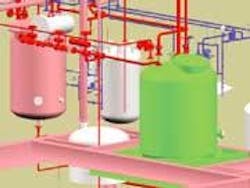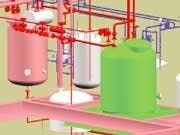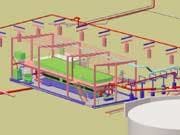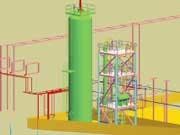3D Modeling Accelerates Design of Wastewater Systems
Bentley Systems of Exton, PA, provides software that allows architects, engineers and designers to create virtual three-dimensional (3D) models to simplify and expedite the design process for wastewater treatment systems.
Before the advent of 3D modeling, errors found in drawings would delay construction time by weeks or even months as expensive redesign was completed in the field. Labor and material costs would often skyrocket beyond anticipated levels as projects fell behind schedule.
With today's technology, the digital models can be thoroughly checked for errors early in the design process, resulting in far fewer surprises in the field. In addition to its effectiveness throughout project lifecycles, 3D software is also particularly useful in sales, enabling firms to illustrate for prospective clients exactly what a completed system will look like and what materials will be used.
Bentley's 3D modeling programs include AutoPLANT and PlantSPACE. AutoPLANT is an add-on to AutoCAD that creates "intelligent" plant models containing both the 3D geometry of the facility and textual information such as specifications. AutoPLANT works with an Access database, which is what engineers use as their facility management software. By using AutoPLANT, all the descriptive information about parts and materials created during the design phase is immediately accessible to operations engineers.
Teams Working in Parallel
One of the most significant benefits of 3D modeling is the ability of multiple design and construction teams to work in parallel rather than having to wait for each step to be completed before beginning the next step. A case in point is a recent wastewater treatment system project designed with Bentley software. The $6.5 million wastewater treatment facility needed retrofit work — to meet Maximum Achievable Control Technology guidelines under the 1990 Clean Air Act — as well as new capacity to expand its treatment infrastructure to handle increased production.
In the past, engineers would have tackled this project using two-dimensional drawings. There were several drawbacks to this approach. First of all, engineers would have had to draw different areas of the plant multiple times in order to see what the configuration looked like from different angles. Secondly, working in 2D made it difficult to detect interferences. To avoid conflicts between the two construction efforts, the teams would have had to swap drawings many times and update their own drawings with the new information as it came from the other team.
Also, old equipment has to be removed during retrofit work so there has to be appropriate clearance. In the past, designers would use plan, section, and elevation views to try spotting clashes and clearance problems. However, if two drawings didn't match perfectly, it was possible for problems to go unnoticed. And perhaps the most time consuming drawback of working in 2D, is that once a design is done, all piping isometrics and other construction drawings needed for fabrication must be generated from scratch.
With 3D modeling software, designers are able to select a desired view of the model and spin-off subsequent drawings, rather than create each drawing by hand. An automatic isometric generator feature of AutoPLANT, known as ISOGEN, allows designers to produce the isometrics in-house, a job normally done by contractors. The software creates isometrics with elevations and dimensions tagged and located, with materials for purchasing automatically derived from the project database.
Rather than drawing equipment and lines, adding bubbles, and putting text in the bubbles that identify the parts, designers are able to insert equipment blocks that automatically do most of that work. If the block was a valve, for example, placing the valve block onto the drawing automatically cut the line. The blocks contain specifications about the part, such as size and identification number. As each equipment block is placed on the drawing, the software creates a database of information, eliminating the need to type that information onto a separate equipment list.
With the new software, while one designer is modeling the piping layout, other designers could install pumps and other devices.
Throughout any given project, the 3D model can be used for design reviews. Designers are able to view from different angles all existing equipment and new equipment to see how they will fit together — something they cannot do in 2D. By using another AutoPLANT feature called Explorer, the design team creates virtual walk-throughs of a wastewater treatment facility. Members of the design team can zoom in on an area of concern, travel up a stairway to determine maintenance access, and walk around equipment to understand head clearance.
In addition to the obvious time-saving advantage of 3D modeling, designers also realize that 3D software will help with business development. As clients learn about the added value in this approach, such as the creation of a specification database, they can also use this in facility management. And those who are familiar with the method, strongly advocate using the 3D plant modeling and will avoid initiating projects without 3D modeling resources in place.



